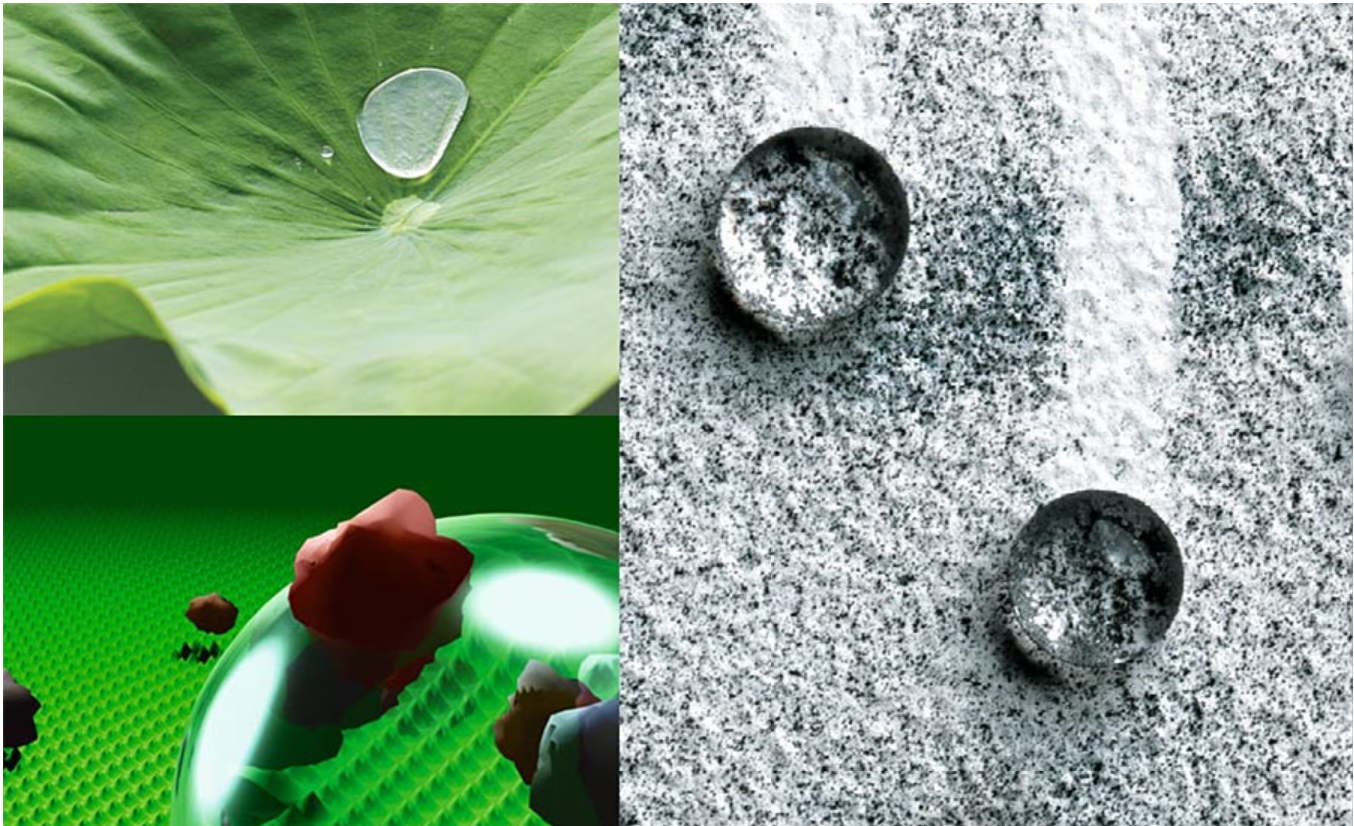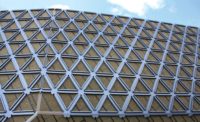Mineral wool is becoming a viable option for continuous, exterior thermal performance in a building system. It was first observed on the Island of Hawaii in the 19th century, when molten volcanic lava was stirred by the wind into fibers that the natives used to blanket their huts. A method of manufacturing this natural mineral fiber was first patented in the United States in 1870 by John Player. Twenty-seven years later, American Engineer Charles Corydon Hall developed a technology to transform molten limestone into fibers and launched the rock wool insulation industry in America.
Today’s mineral wool insulation is produced by heating a molten mix of basalt, or dolomite and slag, derived from steel manufacturing in a furnace at a temperature of about 1,426 degrees Celsius (2,600 degrees Fahrenheit), through which a stream of air is blown. More advanced production techniques involve whirling molten rock and a polymer binder using high-speed spinning heads somewhat like the process used to produce cotton candy. The final product is a mass of fine, intertwined fibers with a diameter that ranges from two to six micrometers. It is typically comprised of mostly inorganic material.
Using mineral wool in your system is a good option for a high-performance building envelope. It has many attributes and characteristics to add fire resistance, permeability and sustainability to a building. When used with an air and moisture barrier, it produces an advanced high-performance wall cladding system.
The individual fibers conduct heat very well, but when pressed into rolls and sheets, their ability to partition air makes them excellent insulators. The layered mat of fibers, which prevents the movement of air, provides a flexibility and versatility not found in most other insulations. Rock and slag wool can be produced in a wide variety of forms, shapes, and sizes, including: board, batt, loose-fill, spray-applied, and pipe insulation for many common and specialized applications.
Mineral wool, for example, is widely used in industrial settings such as petroleum refineries and power plants to contain heat in pipes, tanks and vessels. It is commonly deployed for residential energy efficiency as insulation for lofts, cavity walls, flat roofs and heating systems. In commercial construction, it has typically been used as an insulation layer behind various claddings. Especially, in curtain walls, spandrel panels, rainscreen facades, and now EIFS.
Fire Resistance:
A system using non-organic mineral wool has several features that enhance fire protection of the building and its occupants. The insulation is noncombustible (NFPA 220 Typing of Building Construction Based on the Fire Resistance of their Structural Elements),
continuous and is a “Class A” building material with 0 flame spread and smoke development (ASTM E84 Surface Burning Characteristics of Building Materials). It can withstand temperatures above 2,000 degrees Fahrenheit while still resisting fire. Using mineral wool in an assembly makes for a narrow cavity and stays in place during a fire, thus minimizing any chimney effect. If the air barrier component is bound between two noncombustible materials—gypsum sheathing and mineral wool—it is therefore unexposed in the event of a fire. These design features exempt the mineral wool based system from NFPA 285 and NFPA 268 testing that is typically required for similar foam plastic-based insulated wall assemblies and permit its use on Types I, II, III and IV (noncombustible) construction without height or setback limitations. Mineral wool insulations are used as passive fire protection in many wall assemblies.
Sustainability:
Mineral wool products are typically made from more than 50 percent post-industrial recycled content and contribute to energy conservation, green building and as many as 13 LEED credit categories. Slag wool, in particular, earns additional points because it is comprised of 70 percent or more of recycled steel-industry waste. Used in conjunction with an exterior continuous insulation system such as EIFS, mineral wool can help cut heating and cooling energy consumption and can substantially reduce greenhouse gas emissions over the life of the building.
Thermal control:
Continuous exterior insulation is an effective and practical way to insulate a wall. Stud cavity insulation is only partially effective in insulating a wall since the studs are thermal bridges that conduct heat energy towards the exterior (or interior if in a cooling climate), and as much as 50 percent of R-value can be lost through steel studs. Building codes today prescribe minimum continuous insulation (ci) R-values for wall assemblies. These values are readily achieved with the insulating component of mineral wool with a ci R-value of 4.0 per inch. Other important aspects of a mineral wool insulation system are an ASTM C612 compliant board. Its tensile and compressive strength, dimensional stability and dimensional tolerances are optimized for the direct application of a base coat, reinforcing mesh and finish coats.
Specialty dowels are used to attach the mineral wool insulation board and are designed to minimize or eliminate thermal bridging. These dowels are made of low thermal conductivity material and employ a thermal plug or cap as a thermal break between fasteners and the finished exterior wall surface. For 2-inch insulation thickness, the dowels are surface mounted and the fastener receives a thermal plug. For insulation thickness of 3 or 4 inches, the dowel is countersunk and covered with a thermal cap made of mineral wool and inserted flush with the mineral wool surface. By insulating on the exterior and using specialty dowels that diminish the thermal bridging effect of fasteners, a system with mineral wool maximizes thermal efficiency and occupant comfort with reduced energy consumption and lower energy costs as compared to between-the-stud insulation.
Impact Resistance:
Impact resistance is measured in accordance with ASTM E2486, a test method that uses a standard weight dropped at increasing heights to determine levels of impact resistance that can be achieved. A system using mineral wool will exceed the levels achieved with a typical foam plastic-based system. For example, the standard grade of reinforcing mesh (4.5 ounces) achieves medium impact resistance in a mineral wool system, and the ultra-high impact resistance level recommended for ground floors is achieved with one layer of intermediate mesh as opposed to the two mesh layers typically required for a foam plastic-based system. Areas other than standard or medium impact resistance should be delineated on elevation drawings to signal these special requirements to the contractor. In general, an ultra-high level of impact resistance is recommended for ground floors to a minimum height of six feet (1.8m) and at other areas that may be exposed to abnormal stress or impact.
In some cases, for example, urban areas with heavy pedestrian traffic, industrial areas with forklift traffic, or a hotel with frequent vehicular traffic and luggage carts, an alternative material such as Portland cement stucco, cement board stucco, stone, or tile, may be a more suitable finish as a wainscot or up to full first floor height. A system using mineral wool, like other wall claddings, should be terminated above finished grade. This not only protects the system from ground water and staining or soiling, but it is also important for protection against weed trimmers and other landscaping tools that can damage the system at grade.
Air Leakage Control:
Air leakage through the building envelope can be a source of condensation and water accumulation in walls. It is also a source of heat loss in cold months and a carrier of pollen and other airborne contaminants that can infiltrate and affect indoor air quality. Most building codes today require an air barrier in wall construction, which can enhance building durability, reduce energy consumption, and improve occupant comfort. For an air barrier to be effective it must be continuous. Connections with other air barrier components (e.g., roof material, foundation waterproofing) must be verified for compatibility along with connections to penetrations through the wall assembly—fenestration, scuppers, and dryer vents, for example. An effective mineral wool cladding system should include compatible air barrier components for detailing at joints, seams, and rough openings, and for transitioning to other materials in wall construction. The primary air barrier material is a coating that can be applied by spray, roller or brush (or trowel for some coatings).
Adding enhanced fire protection, sustainability, thermal control and impact resistance to any façade system makes mineral wool a logical value-add for today’s premium exterior wall systems. Mineral wool, which has been around for a long time, is worth investigating when looking at your next high-performance building envelope system.











Report Abusive Comment